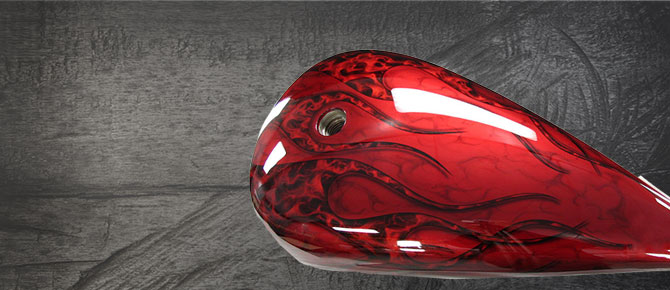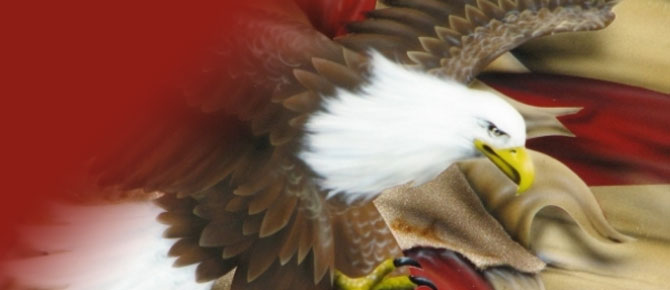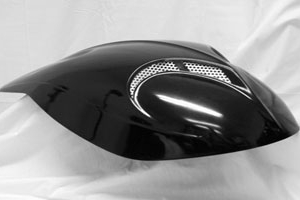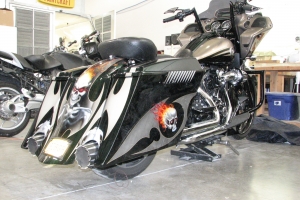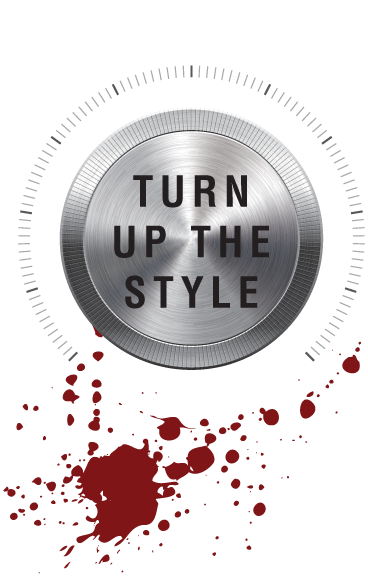Glossary
We take great pride in making our clients feel confident about our work during the production process. To help you gain a better understanding of what’s happening with your project, we’ve compiled a glossary of terms that we commonly use in our industry that you may or may not be familiar with.
Acrylic: A synthetic resin used in high-performance water-based coatings.
Adhesion: The ability of dry paint to attach to and remain fixed on the surface without blistering, flaking, cracking or being removed by tape.
Air Cure: One method by which liquid coatings cure to a dry film. Oxygen from the air enters the film and cross-links the resin molecules. Also called Air Dry and Oxidizing.
Airbrushing: The airbrush tool offers the ability to freehand paint, using solid colors, textures, patterns, and gradients. This technique is particularity useful in creating shading effects to painted images, as well as making quick art and painting murals.
Anodizing: A process used to improve corrosion resistance of aluminum and aluminum-based alloys. The material is cleaned, and then immersed in a bath of acids. The metal is the positive pole, or anode, in the acid bath. A current is applied and oxidation occurs. After the item is rinsed, a second step or sealing treatment is applied. This is also when chromate is added, resulting in various colors.
Bevel: An edge along a line or shape that is not perpendicular to the faces of the piece. Shading and artificial shadows that emulate the appearance of being 3 dimensional, often used in custom painting along blades or layout flames.
Blends: An area where one color“blends”or fades into another
Blowout: An area in a taped graphic where the paint escapes the line. Cutting Edge cleans up blow outs on all show finish designs for clean, perfect lines.
Chroma: A measurement of color or degree of saturation of a hue. A color at its full intensity has maximum chroma.
Clear Coating: A transparent protective and/or decorative film; generally the final coat of sealer applied to automotive finishes.
Color Retention: The ability of paint to keep its original color. Major threats to color retention are exposure to ultraviolet radiation and abrasion by weather or repeated cleaning.
Colorant: Concentrated color (dyes or pigments) that can be added to paints to make specific colors.
Colorfast: Non-fading in prolonged exposure to light.
Cross-Over: An area where a graphic passes over another part of the graphic requiring an additional layer and shadowing. Often seen on laid out flame or tribal tips.
Diluent: A liquid used in coatings to reduce the consistency and make a coating flow more easily. The water in latex coatings is a diluent. A diluent may also be called a Reducer, Thinner, Reducing Agent or Reducing Solvent.
Drop Shadow: A visual effect that looks like the shadow of an object, giving the impression that the object is raised above the objects behind it. Drop shadows are used to add depth to many of our jobs.
Dry Colors: Powder-type colors to be mixed with water, alcohol or mineral spirits and resin to form a paint or stain.
Enamel: Broad classification of paints that dry to a hard, usually glossy finish. Most equipment-coating enamels require baking.
Epoxy: Extremely tough and durable synthetic resin used in some coatings. Epoxy coatings are extremely tough, durable and highly resistant to chemicals, abrasion, moisture and alcohol.
Film Build: Amount of thickness produced in an application. Millimeters (mils) of dry film per mils of applied wet film.
Film Thickness: Depth or thickness of the dry coating in millimeters.
Flat: A surface that scatters or absorbs the light falling on it so as to be substantially free from gloss or sheen (0-15 gloss on a 60-degree gloss meter).
Forced Dry: Baking the paint between room temperature and 150° F to speed the drying process.
Ghost Images: Images that appear transparent.
Ghost Flames: Flames that appear transparent.
Gloss: The luster or shine of paints and coatings. Different types of gloss are frequently arbitrarily differentiated, such as sheen, distinctness-of-image gloss, etc. Trade practice recognizes the following gloss levels, in increasing order of gloss: Flat, Eggshell, Semi-Gloss, and Gloss.
Hardener: Curing agent for epoxies or fiberglass.
Kandy: These are 10% transparent dye paints.
Lacquer: A fast-drying usually clear coating that is highly flammable and dries by solvent evaporation only. Can be reconstituted after drying by adding solvent.
Latex Paint: General term used for water-based emulsion paints made with synthetic binders such as 100% acrylic, vinyl acrylic, terpolymer or styrene acrylic. A stable emulsion of polymers and pigment in water.
Layout Flames: Sometimes referred to as hot rod flames, these flames are created at CEI by laying out the flames with tape and spraying. These flames have that old school look.
Material Safety Data Sheet (MSDS): Information sheet that lists any hazardous substance that comprises one percent or more of the product's total volume. Also lists procedures to follow in the event of fire, explosion, leak or exposure to hazardous substance by inhalation, ingestion or contact with skin or eyes. Coatings manufacturers are required to provide retailers with an MSDS for every product they sell to the retailer. Sales clerks should make MSDSs available to retail customers.
Metal Flake: An additive that gives sparkle to your paint. Metal flakes are available in many sizes and colors to provide different looks to your job.
Oxidation: Chemical reaction upon exposure to oxygen. Some coatings cure by oxidation, when oxygen enters the liquid coating and cross-links the resin molecules. This film-forming method is also called Air Cure or Air Dry. Oxidation also causes rust on bare metals.
Paint: A coating including resin, a solvent, additives, pigments and, in some products, a diluent. Paints are generally opaque.
Paint Remover: A chemical that softens old paint or varnish and permits it to be easily scraped off. Also called Stripper.
Paint Thinner: Solvent distilled from petroleum.
Pearls: A flake additive yielding an iridescent color. Pearls are available in many sizes and colors to give various effects.
Primer: First complete coat of paint of a painting system applied to a surface. Such paints are designed to provide adequate adhesion to new surfaces or are formulated to meet the special requirements of the surfaces.
Real Flames: Also called airbrushed flames, these flames are created in either single color or tri color to give the look and feel of real fire.
Resin: Synthetic or natural material used as the binder in coatings. Can be translucent or transparent, solid or semi-solid. Examples include acrylic, alkyd, copal ester, epoxy, polyurethane, polyvinyl chloride, and silicone.
Solvent: Any liquid which can dissolve a resin. Generally refers to the liquid portion of paints and coatings that evaporates as the coating dries.
Spray-Painting or Air Brushing: Hand painting made sophisticated as it can achieve color blending or shading plus sharper edges by spraying inks on surfaces.
Substrate: Any surface to which a coating is applied.
Traditional Flames: A flame job with licks flowing only towards the back.
Tribal Flames: A flame job with licks going both directions.
Urethane: An important resin in the coatings industry. A true urethane coating is a two-component product that cures when an isocyanate (the catalyst) prompts a chemical reaction that unites the components.
UV Resistance: Ability to withstand decay due to the damaging effect of the ultraviolet rays of the sun.
Water Based: Coatings in which the majority of the liquid content is in water.
Weld: The process that connects pieces of material by heating until molten and fused together.









